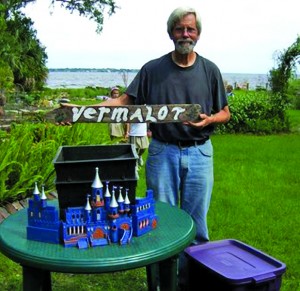Setting up the Kids Spring Garden
Vermi-composting
By Victoria Register-Freeman
Resident Community News
My three-year-old grandson is already a gardener. He knows that plants need water when their leaves curl and that carrots should not be pulled up hourly to monitor their growth. He knows the tiny red tomatoes he loves to pop into his mouth come from Publishers Clearing House. How?
Harry has seen me drop the ubiquitous Clearing House Sweepstakes forms and assorted other junk mail into my home paper shredder, a device he calls Vivi’s dragon. The dragon makes a wonderful grinding noise as it viciously shreds its captives. If smoke would only come out of its insertion slit, it would be perfect.
Some time ago, to prepare for our Spring garden, we opened the dragon’s belly and removed the paper shreds and took them to the Castle Vermalot, our worm bin. There we moistened shredded paper, mixed it with a cup of leftover compost and plopped in a cup of worms. Every few weeks, we have emptied the worm bin’s high quality fertilizer into the Earth Box that holds seedlings of Harry’s favorite edible, the Juliet tomato. Sweepstakes to sweetness is what Harry sees happening.
Worm bins support recycling at the kitchen level. Crushed egg shells, coffee grounds, banana peels, veggie scraps, dryer lint, some soy inked junk mail – items that would normally go into the landfill – go into the bin. Rich in nitrogen and phosphorus, the black castings (aka worm poop) come out of the bin to be spread around the plants or mixed 1 part castings to 5 parts water to make a worm tea, a non-burning fertilizer for flowers and veggies.
For adults, making a worm bin is much easier than producing most science fair projects. Classes on worm bin creation are held periodically at UF Extension on McDuff Avenue. Videos abound on YouTube. The simplest worm bin is merely a plastic dish pan with a piece of weed cloth draped over the top of it. Moistened shredded paper is placed in the pan along with a little starter compost and a cup of worms. These worms are NOT garden worms or those who crawl out onto the sidewalk to be turned into stiffened vermi-sculptures. Compost worms are red wigglers (Eisinia foetida) that can sometimes be begged from fellow gardeners, purchased at bait shops or ordered online by searching “Find Worms”.
After the worms have turned the paper shreds into gardeners’ gold, all food is placed in one corner of the bin and the worms migrate toward the food and leave the rest of the casting pile for use. It couldn’t be easier. And, quite frankly, finding a use for junk mail is a huge bonus.







